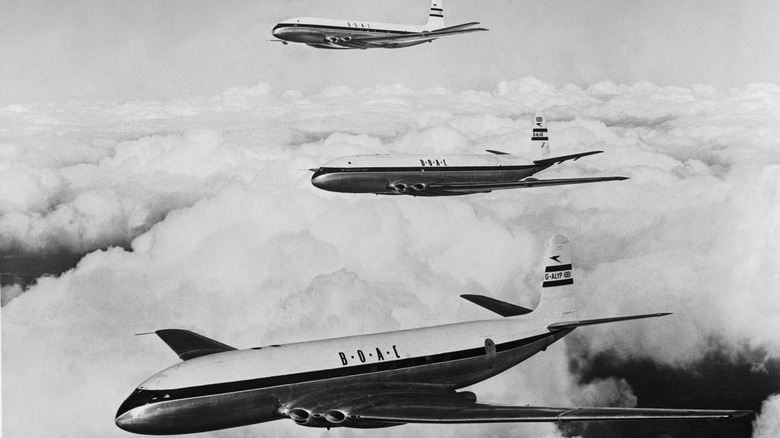Why The World's First Jet Airliner Was A Failure (But Still Revolutionary)
From the early Greek legends of the winged horse Pegasus (7th century BCE), and the wax wings of Icarus, man has dreamt of flying. The progression of flight has been painfully slow, however. The Chinese built kites around 400 BCE, but it took more than a thousand years for someone — in this case, Leonardo da Vinci in the 1480s — to really study flight.
We must jump ahead another 300 years before the Montgolfier Brothers launched the first hot air balloon in 1783. Another 122 years passed before the Wright Brothers did their thing at Kitty Hawk in 1903. 11 years later, the first "commercial" airline sprang up in Florida, but not like you might imagine. The fleet consisted of only one propeller-driven "flying boat" plane, one pilot, and carried only one paying passenger. The 17-mile flight between St. Petersburg and Tampa (over water) took 23 minutes.
In 1926, Western Air Express (which would later become Western Airlines) kicked off the first scheduled passenger service, between Salt Lake City and Los Angeles, using propeller-driven planes and land runways in the United States. However, it would take another 23 years before the jet airliner would make its first appearance.
Sir Geoffrey de Havilland actually watched Wilbur Wright fly a plane in 1908. He went on to build and fly one of his own in 1910 and, by 1920, had created his own company. In 1943, De Havilland developed the concept for the turbojet-powered DH106 "Comet," which would change commercial aviation forever.
Comet led the way for today's commercial airlines
In 1946, three years after initially coming up with the idea, De Havilland began design work on the Comet. This design phase lasted three years, and the first Comet took flight on July 27, 1949. It underwent three more years of testing and tweaking before finally entering service on May 2, 1952, with the British Overseas Aircraft Corporation (BOAC).
The 44-seat (36 of which were for passengers) plane was to travel from London to Johannesburg at 480 miles per hour. Unfortunately, a mere 18 months after that inaugural flight in May of '52, two crashes occurred within three months of each other in 1953 and 1954.
The first crash took place while delivering a plane to Canadian Pacific Air Lines, and as one might expect, the company cancelled the order. The second crash occurred when a BOAC Comet left Kolkata, India, and hit a storm. All 43 people aboard perished. Follow-up investigations and tests showed that after repeated pressurization and depressurization the metal fatigued, and caused cracks in the fuselage.
These setbacks didn't deter De Havilland, as he released a new and improved version of the Comet four years later. However by then, both Boeing and Douglas had produced jet airliners (Boeing's 707 and Douglas' DC-8) and had since taken over the aviation industry.
